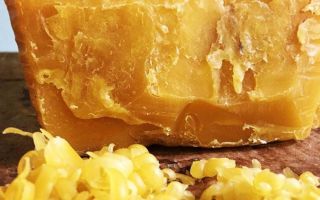Content
- 1 What beeswax looks like
- 2 What it consists of and how bees make wax
- 3 Is it ok to eat or swallow honeycomb wax
- 4 Beeswax composition
- 5 Why beeswax is useful for the human body
- 6 What is beeswax for and where is it used?
- 7 The use of beeswax in traditional medicine
- 7.1 Beeswax for hemorrhoids
- 7.2 Application of beeswax for joint pain
- 7.3 Beeswax for corns and calluses
- 7.4 Beeswax for cracked heels
- 7.5 Beeswax for the treatment of trophic ulcers, wounds and abrasions
- 7.6 Beeswax for periodontal disease
- 7.7 Beeswax for sinusitis
- 7.8 Beeswax for inflammation of the appendages
- 7.9 Beeswax for bronchitis
- 8 The use of beeswax in cosmetology
- 9 Contraindications and possible harm
- 10 How to store beeswax
- 11 Conclusion
- 12 Reviews on the use of beeswax for hair
The use of beeswax in folk medicine deserves attention - the product is used in the treatment of a wide variety of ailments. To get the maximum of valuable properties from a substance, you need to study its features.
What beeswax looks like
Beeswax is obtained from honeycombs, in fact, it is this solid that is white-yellow, brownish or brownish in color. The shade depends on the thickness of the plates, the thinner they are, the lighter the product. In the presence of propolis in the honeycomb, the substance can acquire a slightly greenish color, and with a high content of pollen oils it becomes darker.
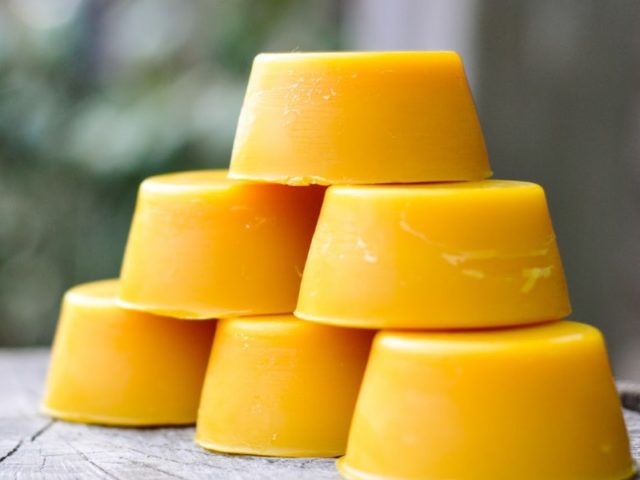
What it consists of and how bees make wax
Wax is an organic matter produced by young worker bees using special glands located on the abdomen. It should be noted that in insects that make daily flights for pollen, these organs atrophy; they can be found only in individuals that have not yet left the hive. The substance secreted by the glands is at first liquid, and only under the influence of air hardens and acquires a dense structure.
To obtain beeswax, beekeepers reheat and filter the honeycomb to separate impurities. Often the procedure is carried out several times in a row. In this case, beeswax is obtained with a uniform yellow hue. Then it is poured into special molds for cooling, and after extraction it becomes ready for use.
Is it ok to eat or swallow honeycomb wax
The product is not digested in the stomach, therefore it is not recommended to use it in large quantities. However, beeswax can be eaten in small dosages, especially with honey. This will not harm your health; on the contrary, it will help cleanse the intestines. But the daily volume of the substance should not exceed 15 g.
Beeswax composition
Beeswax contains several hundred chemical compounds. Among the main ones you can list:
- esters formed by organic acids - palmitic, melissinic and others;
- fatty acids - oleic, montanic, cerotinic;
- water;
- saturated hydrocarbons pentacosane and heptacosane;
- alcohols - ceryl, lemon balm, neoceryl;
- remnants of propolis and pollen.
The exact composition of the substance depends, among other things, on the breed of bees and on the diet of insects.
Why beeswax is useful for the human body
A natural bee product in folk medicine and pharmaceuticals is used both internally and externally. The substance benefits:
- with inflammation of the oral cavity, with its help you can cope with bleeding gums, eliminate bad smell;
- in case of digestive disorders, when chewing, the bee product releases useful substances that quickly enter the bloodstream through the mucous membranes, and also stimulates the production of gastric juice;
- for skin diseases - compresses and applications promote healing of the epidermis and relieve irritation.
Home beeswax is used in nail care, the plates become stronger and acquire a beautiful shine. The product copes well with any bacterial and infectious processes in the body.
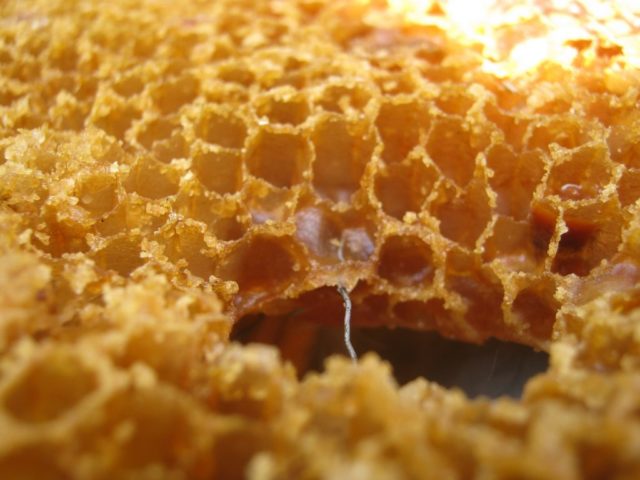
What is beeswax for and where is it used?
Beeswax has properties that are beneficial for many diseases. In particular, the substance:
- serves as the prevention of colds and contributes to their rapid healing;
- works as a natural antiseptic and antibiotic;
- eliminates inflammation of the oral cavity;
- removes harmful substances and poisons from the body;
- helps to get rid of nicotine addiction;
- normalizes blood circulation and strengthens blood vessels;
- promotes the healing of wounds, ulcers, abrasions and burns;
- benefits in arthritis, osteochondrosis, rheumatism and radiculitis;
- relieves swelling;
- replaces toothpaste.
The use of beeswax is practiced not only in medicine, but also in other areas. In particular, it is actively used for the production of foundation, added as a thickener to lipsticks, creams and ointments. The product serves as a raw material for candles, it is coated with some types of cheese to protect it from drying out. You can find it in the composition of polishing products for parquet and furniture, it is added to protective mastics. Models for casting are melted from the bee substance.
The use of beeswax in traditional medicine
Mainly, the bee product for treatment is used by external methods. The substance brings relief from inflammatory processes, from damage to the skin and tissues, from coughs and colds.
Beeswax for hemorrhoids
You can use the bee product for making homemade rectal suppositories for internal hemorrhoids. They are done as follows:
- 10 g of yellow wax is rubbed, and then the chips are melted in a water bath;
- 6 large tablespoons of chopped yarrow herb are added to the liquid substance;
- the mixture is cooled a little, and then small candles are rolled out of it.
It is necessary to inject wax suppositories inside the body twice a day. In total, treatment continues for no more than ten days.
Application of beeswax for joint pain
With osteochondrosis, arthritis and arthrosis, treatment with beeswax helps. Usually such an ointment is prepared:
- 50 g of the bee product is melted in a water bath or steamed;
- make a large spoonful of carefully chopped St. John's wort and yarrow;
- mix the components.
With warm ointment, the joints are rubbed shortly before bedtime, and then a cloth bandage is applied and left overnight.
Also, for joint diseases, compresses can be done. The recipe looks like this:
- 100 g of melted bee product is mixed with a small spoonful of honey;
- bring the components to homogeneity.
The mixture is applied to the diseased areas, covered with a film on top and wrapped in a woolen scarf. You need to keep the compress for an hour, it is recommended to repeat the procedure within ten days.
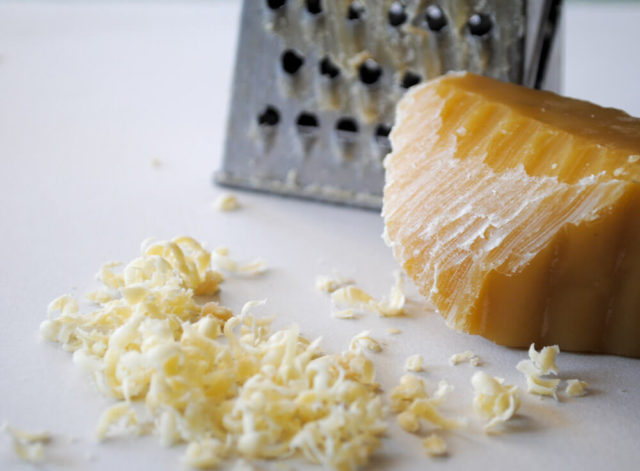
Beeswax for corns and calluses
The external use of beeswax in medicine is beneficial for calluses and rough skin of the feet.The following mixture is usually made:
- 40 g of the bee product is melted to a liquid state;
- mixed in equal proportions with warmed up crushed propolis;
- add a small spoonful of lime juice.
The legs are pre-steamed properly, and then the healing mixture is applied to the affected areas and covered with a bandage. You need to keep the bandage for a couple of hours. When using the product, calluses heal quickly, and calluses after a few sessions soften noticeably, and it becomes easier to remove them.
Beeswax for cracked heels
At home, beeswax is used for cracked heels. The drug is done as follows:
- 50 g of the bee product is heated to a liquid state;
- add 15 drops of sea buckthorn oil;
- make 15 g of powder from licorice root;
- stir the ingredients.
Legs are lightly steamed in hot water, blotted with a towel and the mixture is applied for about 20 minutes. Then the agent is washed off and its remains are removed with a cotton pad, and finally a small amount of pure bee product is rubbed into the feet. It is best to carry out the procedure in the evening, in order to immediately give your legs a rest.
Beeswax for the treatment of trophic ulcers, wounds and abrasions
The use of natural beeswax is justified in case of mechanical damage to the skin and trophic ulcers. To create a drug you need:
- mix 150 ml of a decoction of nettle and 100 g of melted resin;
- add 30 g of hemp seeds;
- add 50 ml of chamomile broth and 60 ml of aloe juice;
- melt 250 g of beeswax to a liquid state;
- combine all the ingredients and add a large spoonful of olive oil.
The product is thoroughly mixed, and then placed in a water bath for half an hour. The finished balm is filtered and poured into a glass vessel. It is necessary to apply it to problem areas of the skin twice a day for 30 minutes, after the expiration of the damage period, rinse with warm water.
Beeswax for periodontal disease
For gum disease and bleeding, beeswax is used in solid form, without prior melting. A small piece is simply chewed slowly for ten minutes, and then spit out. In the process, the bee product releases useful substances that soothe and disinfect mucous membranes. It is recommended to chew the product daily until the condition improves.
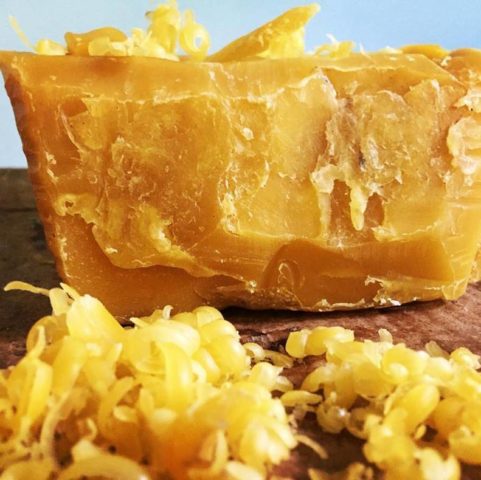
The procedure not only eliminates painful sensations in case of gum ailments, but also helps to clean teeth and remove plaque and food debris from them.
Beeswax for sinusitis
With chronic sinusitis, the beneficial properties of beeswax can relieve inflammation in the sinuses, draw out accumulated pus, remove puffiness and free breath. The drug is prepared as follows:
- 50 g of bee substance is rubbed on a fine grater;
- mixed with boiled crushed yolk;
- add 150 g of olive oil;
- mix the ingredients until smooth.
The mixture is heated over low heat until the components are completely dissolved, and then cooled. You can use the composition for instillation of two drops into each nostril or as a nasal ointment.
Beeswax for inflammation of the appendages
The beneficial properties of the bee product help to eliminate inflammation of the appendages and relieve soreness in the lower abdomen. Traditional medicine offers the following recipe:
- 10 g of yellow wax is ground and mixed with 10 ml of calendula alcohol tincture;
- add 50 g of crushed white wax and margarine;
- mix the components and heat with steam until dissolved.
In a warm form, the product is applied with a compress to the lower abdomen or lower back, covered with a film and a bandage and left for 40 minutes.
Beeswax for bronchitis
With bronchitis and severe coughing, the use of beeswax inside in combination with other components brings a good effect. The tool is done like this:
- the bee substance is crushed to shavings in the volume of one glass;
- mixed with an equal amount of honey and pine resin;
- add a glass of unrefined sunflower oil;
- place the ingredients in an enamel pan and put on low heat;
- melt until smooth with continuous stirring.
You need to take the remedy inside a small spoon three times a day on an empty stomach.
The use of beeswax in cosmetology
Noteworthy are the benefits and harms of beeswax for the face and hair. The bee product is often added to store cosmetics - creams, balms, masks and wraps. You can use it at home in combination with other useful ingredients.
Beeswax for hair
With weakened and damaged hair due to frequent dyeing, the product is allowed to be used to restore the structure of curls and strengthen the subcutaneous follicles. The following mask can be made from beeswax:
- 1/4 cup of the substance is melted in a water bath;
- add 15 ml of apricot, sea buckthorn and wheat oils;
- add two drops of coconut and linseed ethers;
- mix and cool the product until warm.
The mask must be rubbed into the curls in the direction of their growth, not forgetting to especially carefully process the root zone. Then the head is wrapped with a film and a towel and the mixture is left for 40 minutes. Rinse off the product with natural shampoo, and repeat the procedure twice a week.
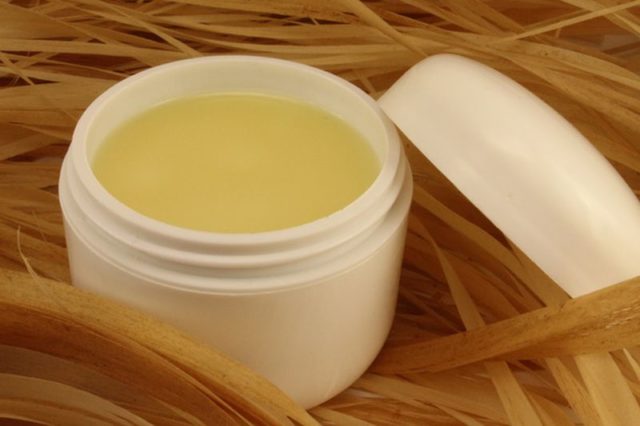
Beeswax for leather
The healing properties of beeswax are actively used to care for oily and dry skin. The substance helps to get rid of irritations, acne and acne, eliminates the first wrinkles and supplies the epidermis with nutrients. With regular use of the bee product, the face becomes smoother and more elastic, the production of subcutaneous fat is normalized, and the pores are cleansed.
For dry skin type and signs of wilting, you can use the following mask:
- 50 g of the melted bee product is mixed with ten drops of peach and jasmine oils;
- add five drops of pumpkin and avocado pomace;
- make ten drops of liquid retinol.
Beeswax for wrinkles is stirred and applied to the face for 15 minutes. Rinse off the mask with lukewarm water, while using soap is optional.
Beeswax for nails
The bee product helps prevent delamination of the nail plates, restore their natural shine, soften the cuticles and eliminate inflamed wounds. It is used in several ways:
- rub the clean melted substance into the nail plates and leave for half an hour;
- add a small spoonful of liquid product to hot hand baths;
- prepare a cream - add 5 drops of your favorite essential and base oils to 50 g of wax, taken as a base.
For problem nails, it is recommended to use a bee product for care at least three times a week on a regular basis.
Contraindications and possible harm
The bee product is considered to be quite safe. It is strictly contraindicated only in the presence of an individual allergy. For the first time, use the product internally and apply to the skin with great care, carefully monitoring the body's response.
Otherwise, the substance can be used quite freely. It is necessary to remember only about moderate dosages when taken internally - no more than 15 g per day.
How to store beeswax
Natural wax is a substance very resistant to external conditions. The product is not afraid of high humidity and does not oxidize from contact with air, does not dry out, does not grow moldy and does not deteriorate.
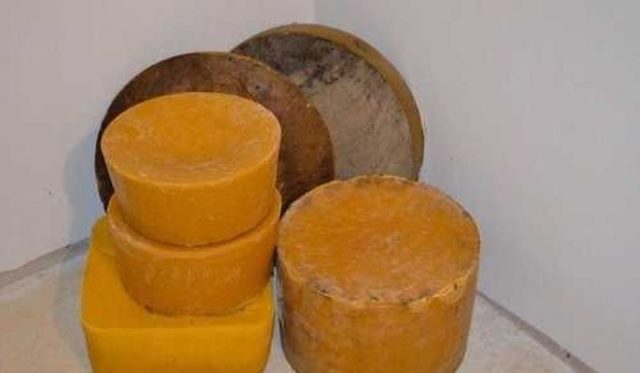
The only weak point of the substance is the high degree of odor absorption. Therefore, it is not recommended to keep wax next to spices, seasonings and other strongly smelling foods. You also need to ensure that pests and insects do not have access to it. It is best to store the wax in a dry glass container at a temperature of about 20 degrees, away from sunlight.
The shelf life of beeswax is not limited, it can be used for years. Over time, a light gray bloom may appear on the surface of the substance, but it does not pose a danger, but only once again confirms the natural origin.
Conclusion
The use of beeswax in folk medicine is very wide. The tool is used most often for compresses and applications for joint and colds. But you can even use it inside, if you observe small dosages.
Reviews on the use of beeswax for hair

